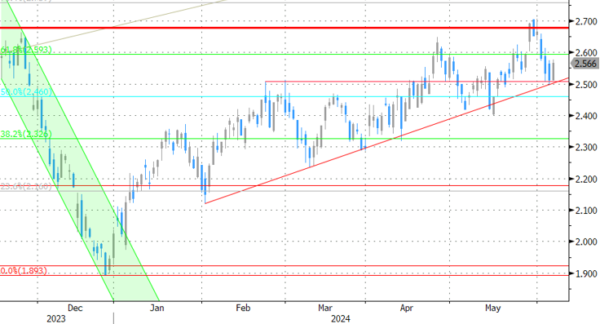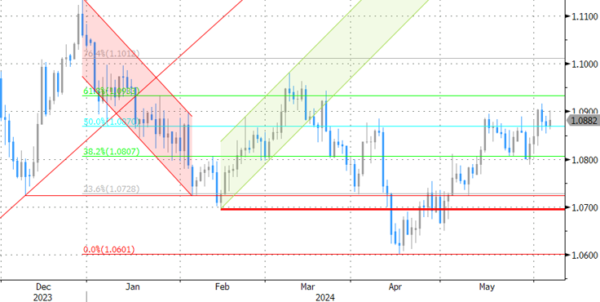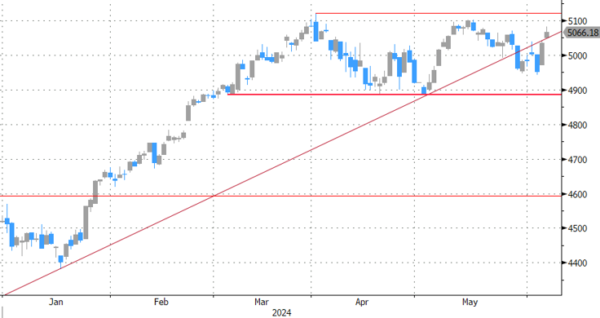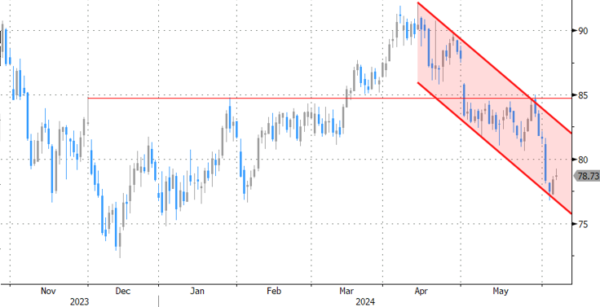Markets
After the Swiss National Bank (March), the Swedish Riksbank (May) and the Bank of Canada (yesterday), the ECB today is the next in line among central banks from developed economies to reduce policy restriction. It cut its policy rates by 25bps, bringing the deposit rate from 4.0% to 3.75%. ECB assesses that the dynamics of underlying inflation and the strength of monetary policy transmission after nine months of holding rates steady, justifies to moderate the degree of monetary policy restriction. However, despite the progress inflation, the ECB admits that domestic price pressures remain strong as wage growth is elevated with inflation likely holding above target well into next year. Staff projections even were upwardly revised both headline (2024 2.5% from 2.3%; 2025 2.2% from 2.0%) and core (2024 2.8% from 2.6%, 2025 2.2% from 2.1%) inflation. Forecasts were left unchanged for 2026 (1.9 % headline; 2.0% core). Growth is expected to pick up to 0.9% in 2024, 1.4% in 2025 and 1.6% in 2026. Looking forward, the ECB commits to keep rates sufficiently restrictive as necessary to bring inflation to 2.0% in a timely manner. In a data-dependent approach, the bank doesn’t commit to any particular rate path. The ECB continues to run-off of its APP portfolio and from H2 2024 will also reduce the PEPP portfolio by € 7.5 bln p/month as earlier announced. From a communication point of view, it wasn’t that easy to explain less policy restriction as inflation is expected to stay longer above target than initially expected and as wage growth remains elevated. This complicates the pace/timing of further steps. EMU/German yields rebounded up to 5 bps after the release of the policy statement and this rise was maintained during Lagarde’s press conference as the ECB Chair indicated that further easing needs the backing of data and that the ECB is not in in a phase of (automatically) dialing back. German yields currently rise between 6.0 bps (5-y) and 4.0 bps (30-y). Markets still see a 90% change of next step in September and about 70% of two additional cuts by the end of the year. US Treasuries outperform Bunts with yields adding about 1-2 bps across the curve. Jobless claims printed higher than expected at 229k and Q1 unit labour costs was substantially downwardly (4.0% from 4.7%) wiht markets looking forward to tomorrow’s US payrolls. The ECB decision had little impact on EMU equities. EuroStoxx 50 still holds a 0.65% again. EUR/USD dropped to the 1.0865 area going into the ECB decision, but again trades near 1.088 as the timing of further cuts stays (highly) conditional. The rebound of the euro also helped EUR/GBP to create some breathing space from the key 0.8490/8500 support area (currently 0.8520).
News & Views
British CFO’s in the Bank of England’s Decision Maker Panel (DMP) for May expect output prices to rise 3.9% (three-month smoothed average) in the year ahead. That’s slightly down from the 4% in the DMP’s previous edition. Consumer price inflation for the upcoming year is seen rising 3% in the three months to May, easing further from the 3.1% in April. The gauge for three-year ahead CPI dropped further from 2.7% to 2.6% and should be welcomed by the Bank of England as it suggests the risk of unanchored inflation expectations so far does not materialize. Firms reported 1.5% employment growth in May, slower than the 1.7% in April as well as the slowest pace since November 2021. Employment growth for the year ahead is anticipated at 1.3%, the same as in April. Expected year-ahead wage growth fell by 0.3 ppts to 4.5% on a three-month moving-average basis in May.
Sticking to the UK, the central bank said it allotted more than £19bn in its weekly repo operation on Thursday. That’s up from £17.2bn in the week before and the seventh straight week of record demand. The uptick is at least partially the result of the BoE’s quantitative tightening programme through which it reduces excess liquidity in the market. Contrasting with the ECB and the Fed, the BoE sets an annual QT target in September for the year ahead and effectively sells gilts if bond expiries alone are not enough to hit that mark. The Bank of England is moving the fastest of all three, currently holding £700bn of bonds compared to a peak of <£900bn in early 2022. While the huge uptake could be viewed as signs of emerging liquidity scarcity, other metrics (e.g. minimal market repo rate premium over the Bank Rate) offer no reason to worry just yet. Moreover, the shift is exactly what the central bank wants. Its governor Bailey end May revealed the aim to provide liquidity the traditional way through repo’s instead of (unconventional) QE in order to avoid interest rate risk.
Graphs
German 10-y yield holding above 2024 uptrend line as any further ECB cuts remain conditional on additional data confirmation.
EUR/USD holding near recent top, but no real test of 1.0916 resistance.
EuroStoxx 50 again nearing cycle top as markets ponder chances of (global) policy easing.
Brent oil ($ p/b) struggles even as OPEC+ sees reaction to its June 02 decision as not justified.

















